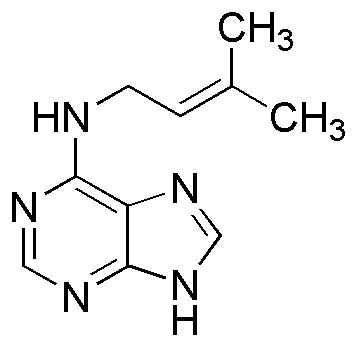6-(3,3-dimethylallylamino)purine is widely utilized in research focused on:
- Plant Growth Regulation: This compound is known for its role as a plant growth regulator, enhancing cell division and promoting root and shoot development in various crops.
- Biotechnology Applications: It is used in tissue culture to stimulate the growth of plant cells, making it essential for researchers working on plant propagation and genetic modification.
- Pharmaceutical Research: The compound has potential applications in developing new drugs, particularly in targeting purine metabolism, which is crucial for various biological processes.
- Cellular Studies: It serves as a tool in cellular and molecular biology studies, helping researchers understand signaling pathways and cellular responses to growth factors.
- Agrochemical Development: Its properties make it a candidate for developing new agrochemicals that can improve crop yield and resistance to environmental stressors.
General Information
Properties
Safety and Regulations
Applications
6-(3,3-dimethylallylamino)purine is widely utilized in research focused on:
- Plant Growth Regulation: This compound is known for its role as a plant growth regulator, enhancing cell division and promoting root and shoot development in various crops.
- Biotechnology Applications: It is used in tissue culture to stimulate the growth of plant cells, making it essential for researchers working on plant propagation and genetic modification.
- Pharmaceutical Research: The compound has potential applications in developing new drugs, particularly in targeting purine metabolism, which is crucial for various biological processes.
- Cellular Studies: It serves as a tool in cellular and molecular biology studies, helping researchers understand signaling pathways and cellular responses to growth factors.
- Agrochemical Development: Its properties make it a candidate for developing new agrochemicals that can improve crop yield and resistance to environmental stressors.
Documents
Safety Data Sheets (SDS)
The SDS provides comprehensive safety information on handling, storage, and disposal of the product.
Product Specification (PS)
The PS provides a comprehensive breakdown of the product’s properties, including chemical composition, physical state, purity, and storage requirements. It also details acceptable quality ranges and the product's intended applications.
Certificates of Analysis (COA)
Search for Certificates of Analysis (COA) by entering the products Lot Number. Lot and Batch Numbers can be found on a product’s label following the words ‘Lot’ or ‘Batch’.
*Catalog Number
*Lot Number
Certificates Of Origin (COO)
This COO confirms the country where the product was manufactured, and also details the materials and components used in it and whether it is derived from natural, synthetic, or other specific sources. This certificate may be required for customs, trade, and regulatory compliance.
*Catalog Number
*Lot Number
Safety Data Sheets (SDS)
The SDS provides comprehensive safety information on handling, storage, and disposal of the product.
DownloadProduct Specification (PS)
The PS provides a comprehensive breakdown of the product’s properties, including chemical composition, physical state, purity, and storage requirements. It also details acceptable quality ranges and the product's intended applications.
DownloadCertificates of Analysis (COA)
Search for Certificates of Analysis (COA) by entering the products Lot Number. Lot and Batch Numbers can be found on a product’s label following the words ‘Lot’ or ‘Batch’.
*Catalog Number
*Lot Number
Certificates Of Origin (COO)
This COO confirms the country where the product was manufactured, and also details the materials and components used in it and whether it is derived from natural, synthetic, or other specific sources. This certificate may be required for customs, trade, and regulatory compliance.


